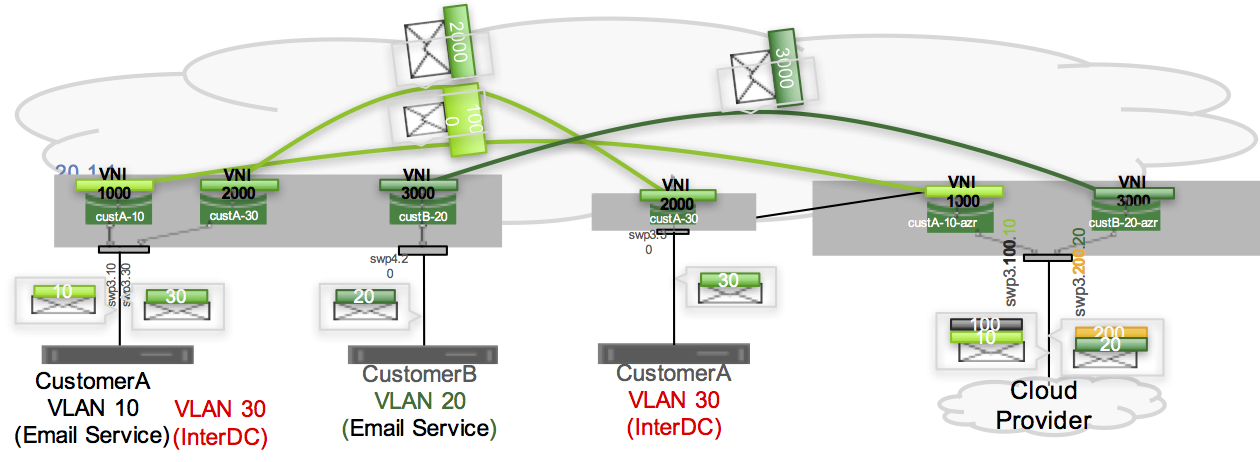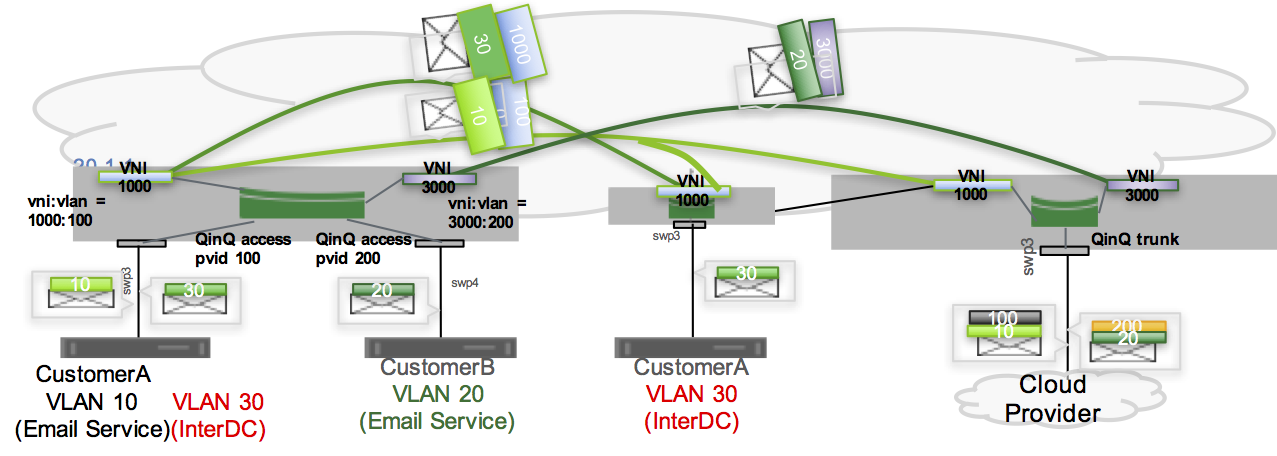Hybrid Cloud Connectivity with QinQ and VXLANs
QinQ is an amendment to the IEEE 802.1Q specification that provides the capability for multiple VLAN tags to be inserted into a single Ethernet frame.
The primary use case for QinQ with VXLAN is where a service provider who offers multi-tenant layer 2 connectivity between different customers' data centers (private clouds) may also need to connect those data centers to public cloud providers. Public clouds often has a mandatory QinQ handoff interface, where the outer tag is for the customer and the inner tag is for the service.
In Cumulus Linux, you map QinQ packets to VXLANs through:
- Single tag translation, where you map a customer to a VNI and preserve the service as an inner VLAN inside a VXLAN packet.
- Double tag translation, where you map a customer and service to a VNI.
QinQ is available on the following switches:
- Broadcom Tomahawk 2, Tomahawk+, Tomahawk, Trident3, Trident II+ and Trident II switches.
- Spectrum 1 switches, only with VLAN-aware bridges with 802.1ad and only with single tag translation.
Remove the Early Access QinQ Metapackage
If you are upgrading Cumulus Linux from a version earlier than 3.4.0 and
had installed the early access QinQ metapackage, you need to remove the
cumulus-qinq metapackage before upgrading to Cumulus Linux 3.4.0 or
later. To remove the cumulus-qinq metapackage, read the
early access feature
article.
Configure Single Tag Translation
Single tag translation adheres to traditional QinQ service model. The customer-facing interface is a QinQ access port with the outer S-tag being the PVID, representing the customer. The S-tag is translated to a VXLAN VNI. The inner C-tag, which represents the service, is transparent to the provider. The public cloud handoff interface is a QinQ trunk where packets on the wire carry both the S-tag and the C-tag.
Single tag translation works with both VLAN-aware bridge mode and traditional bridge mode. However, single tag translation with VLAN-aware bridge mode is more scalable.
An example configuration with VLAN-aware bridge mode looks like this:

You configure two switches: one at the service provider edge that faces the customer (the switch on the left above), and one on the public cloud handoff edge (the righthand switch above).
All edges need to support QinQ with VXLANs to correctly interoperate.
Configure the Public Cloud-facing Switch
For the switch facing the public cloud:
- Configure the bridge with
vlan_protocolset to 802.1ad. - The VNI maps back to S-tag (customer).
- A trunk port connected to the public cloud is the QinQ trunk, and packets are double tagged, where the S-tag is for the customer and the C-tag is for the service.
To configure the public cloud-facing switch, run the following NCLU commands:
cumulus@switch:~$ net add vxlan vni-1000 vxlan id 1000
cumulus@switch:~$ net add vxlan vni-1000 vxlan local-tunnelip 10.0.0.1
cumulus@switch:~$ net add vxlan vni-1000 bridge access 100
cumulus@switch:~$ net add vxlan vni-3000 vxlan id 3000
cumulus@switch:~$ net add vxlan vni-3000 vxlan local-tunnelip 10.0.0.1
cumulus@switch:~$ net add vxlan vni-3000 bridge access 200
cumulus@switch:~$ net add vxlan vni-1000 bridge learning off
cumulus@switch:~$ net add vxlan vni-3000 bridge learning off
cumulus@switch:~$ net add bridge bridge vlan-protocol 802.1ad
cumulus@switch:~$ net add bridge bridge ports swp3,vni-1000,vni-3000
cumulus@switch:~$ net pending
cumulus@switch:~$ net commit
These commands create the following configuration in the
/etc/network/interfaces file:
auto vni-1000
iface vni-1000
bridge-access 100
bridge-learning off
vxlan-id 1000
vxlan-local-tunnelip 10.0.0.1
auto vni-3000
iface vni-3000
bridge-access 200
bridge-learning off
vxlan-id 3000
vxlan-local-tunnelip 10.0.0.1
auto bridge
iface bridge
bridge-ports swp3 vni-1000 vni-3000
bridge-vids 100 200
bridge-vlan-aware yes
bridge-vlan-protocol 802.1ad
Configure the Customer-facing Edge Switch
For the switch facing the customer:
- Configure the bridge with
vlan_protocolset to 802.1ad. - The customer interface is the QinQ access port, the PVID is the S-tag (customer) and is mapped to a VNI.
- The service VLAN tags (C-tags) are preserved during VXLAN encapsulation.
To configure the customer-facing switch, run the following NCLU commands:
cumulus@switch:~$ net add interface swp3 bridge access 100
cumulus@switch:~$ net add interface swp4 bridge access 200
cumulus@switch:~$ net add vxlan vni-1000 vxlan id 1000
cumulus@switch:~$ net add vxlan vni-1000 vxlan local-tunnelip 10.0.0.1
cumulus@switch:~$ net add vxlan vni-1000 bridge access 100
cumulus@switch:~$ net add vxlan vni-3000 vxlan id 3000
cumulus@switch:~$ net add vxlan vni-3000 vxlan local-tunnelip 10.0.0.1
cumulus@switch:~$ net add vxlan vni-3000 bridge access 200
cumulus@switch:~$ net add vxlan vni-1000 bridge learning off
cumulus@switch:~$ net add vxlan vni-3000 bridge learning off
cumulus@switch:~$ net add bridge bridge ports swp3,swp4,vni-1000,vni-3000
cumulus@switch:~$ net add bridge bridge vlan-protocol 802.1ad
cumulus@switch:~$ net pending
cumulus@switch:~$ net commit
These commands create the following configuration in the
/etc/network/interfaces file:
auto vni-1000
iface vni-1000
bridge-access 100
bridge-learning off
vxlan-id 1000
vxlan-local-tunnelip 10.0.0.1
auto vni-3000
iface vni-3000
bridge-access 200
bridge-learning off
vxlan-id 3000
vxlan-local-tunnelip 10.0.0.1
auto swp3
iface swp3
bridge-access 100
auto swp4
iface swp4
bridge-access 200
auto bridge
iface bridge
bridge-ports swp3 swp4 vni-1000 vni-3000
bridge-vids 100 200
bridge-vlan-aware yes
bridge-vlan-protocol 802.1ad
View the Configuration
In the output below, customer A is on VLAN 100 (S-TAG) and customer B is on VLAN 200 (S-TAG).
To check the public cloud-facing switch, use net show bridge vlan:
cumulus@switch:~$ net show bridge vlan
Interface VLAN Flags VNI
----------- ------ --------------------- -----
swp3 1 PVID, Egress Untagged
100
200
vni-1000 100 PVID, Egress Untagged 1000
vni-3000 200 PVID, Egress Untagged 3000
To check the customer-facing switch, use net show bridge vlan:
cumulus@switch:~$ net show bridge vlan
Interface VLAN Flags VNI
----------- ------ --------------------- -----
swp3 100 PVID, Egress Untagged
swp4 200 PVID, Egress Untagged
vni-1000 100 PVID, Egress Untagged 1000
vni-3000 200 PVID, Egress Untagged 3000
To verify that the bridge is configured for QinQ, run
ip -d link show bridge and look for vlan_protocol 802.1ad in the output:
cumulus@switch:~$ sudo ip -d link show bridge
287: bridge: <BROADCAST,MULTICAST,UP,LOWER_UP> mtu 1500 qdisc noqueue state UP mode DEFAULT group default
link/ether 06:a2:ae:de:e3:43 brd ff:ff:ff:ff:ff:ff promiscuity 0
bridge forward_delay 1500 hello_time 200 max_age 2000 ageing_time 30000 stp_state 2 priority 32768 vlan_filtering 1 vlan_protocol 802.1ad bridge_id 8000.6:a2:ae:de:e3:43 designated_root 8000.6:a2:ae:de:e3:43 root_port 0 root_path_cost 0 topology_change 0 topology_change_detected 0 hello_timer 0.00 tcn_timer 0.00 topology_change_timer 0.00 gc_timer 64.29 vlan_default_pvid 1 vlan_stats_enabled 1 group_fwd_mask 0 group_address 01:80:c2:00:00:08 mcast_snooping 0 mcast_router 1 mcast_query_use_ifaddr 0 mcast_querier 0 mcast_hash_elasticity 4096 mcast_hash_max 4096 mcast_last_member_count 2 mcast_startup_query_count 2 mcast_last_member_interval 100 mcast_membership_interval 26000 mcast_querier_interval 25500 mcast_query_interval 12500 mcast_query_response_interval 1000 mcast_startup_query_interval 3125 mcast_stats_enabled 1 mcast_igmp_version 2 mcast_mld_version 1 nf_call_iptables 0 nf_call_ip6tables 0 nf_call_arptables 0 addrgenmode eui64
Example Configuration with Traditional Bridge Mode
An example configuration for single tag translation in traditional bridge mode on a leaf switch is shown below.
Example /etc/network/interfaces File
auto swp3.11
iface swp3.11
vlan-protocol 802.1ad
auto vxlan101
iface vxlan101
vxlan-id 101
vxlan-local-tunnelip 10.0.0.13
auto br11
iface br11
bridge-ports swp3.11 vxlan101
bridge-learning vxlan101=off
Configure Double Tag Translation
Double tag translation involves a bridge with double-tagged member interfaces, where a combination of the C-tag and S-tag map to a VNI. You create the configuration only at the edge facing the public cloud. The VXLAN configuration at the customer-facing edge doesn’t need to change.
The double tag is always a cloud connection. The customer-facing edge is either single-tagged or untagged. At the public cloud handoff point, the VNI maps to double VLAN tags, with the S-tag indicating the customer and the C-tag indicating the service.
The configuration in Cumulus Linux uses the outer tag for the customer and the inner tag for the service.
You configure a double-tagged interface by stacking the VLANs in the following manner: <port>.<outer tag>.<inner tag>. For example, consider swp1.100.10: the outer tag is VLAN 100, which represents the customer, and the inner tag is VLAN 10, which represents the service.
The outer tag or TPID (tagged protocol identifier) needs the
vlan_protocol to be specified. It can be either 802.1Q or 802.1ad.
If 802.1ad is used, it must be specified on the lower VLAN device, such
as swp3.100 in the example below.
Double tag translation only works with bridges in traditional mode (not VLAN-aware mode).
An example configuration could look like the following:

To configure the switch for double tag translation using the above
example, edit the /etc/network/interfaces file in a text editor and add the
following:
auto swp3.100
iface swp3.100
vlan_protocol 802.1ad
auto swp3.100.10
iface swp3.100.10
mstpctl-portbpdufilter yes
mstpctl-bpduguard yes
auto vni1000
iface vni1000
vxlan-local-tunnelip 10.0.0.1
mstpctl-portbpdufilter yes
mstpctl-bpduguard yes
vxlan-id 1000
auto custA-10-azr
iface custA-10-azr
bridge-ports swp3.100.10 vni1000
bridge-vlan-aware no
bridge-learning vni1000=off
You can check the configuration with the brctl show command:
cumulus@switch:~$ sudo brctl show
bridge name bridge id STP enabled interfaces
custA-10-azr 8000.00020000004b yes swp3.100.10
vni1000
custB-20-azr 8000.00020000004b yes swp3.200.20
vni3000
If the bridge is not VXLAN-enabled, the configuration looks like this:
auto swp5.100
iface swp5.100
vlan-protocol 802.1ad
auto swp5.100.10
iface swp5.100.10
mstpctl-portbpdufilter yes
mstpctl-bpduguard yes
auto br10
iface br10
bridge-ports swp3.10 swp4 swp5.100.10
bridge-vlan-aware no

Caveats and Errata
Feature Limitations
-
iptablesmatch on double-tagged interfaces is not supported. -
Single-tagged translation supports only VLAN-aware bridge mode with the bridge’s VLAN 802.1ad protocol.
-
MLAG is only supported with single-tagged translation.
-
Mixing 802.1Q and 802.1ad subinterfaces on the same switch port is not supported.
-
When configuring bridges in traditional mode, all VLANs that are members of the same switch port must use the same
vlan_protocol. -
When using switches with Spectrum ASICs in an MLAG pair:
- The peerlink (peerlink.4094) between the MLAG pair should be configured for VLAN protocol 802.1ad.
- The peerlink cannot be used as a backup datapath in the event that one of the MLAG peers loses all uplinks.
-
For switches with any type of Spectrum ASIC, when the bridge VLAN protocol is 802.1ad and is VXLAN-enabled, either:
- All bridge ports are access ports, except for the MLAG peerlink.
- All bridge ports are VLAN trunks.
This means the switch terminating the cloud provider connections (double-tagged) cannot have local clients; these clients must be on a separate switch.
Long Interface Names
The Linux kernel limits interface names to 15 characters in length. For QinQ interfaces, this limit can be reached fairly easily.
To work around this issue, you’ll need to create two VLANs as nested VLAN raw devices, one for the outer tag and one for the inner tag. For example, you can’t create an interface called swp50s0.1001.101, since it has 16 characters in its name. Instead, you’ll create VLANs with IDs 1001 and 101 as follows by editing /etc/network/interfaces and adding a configuration like the following:
auto vlan1001
iface vlan1001
vlan-id 1001
vlan-raw-device swp50s0
vlan-protocol 802.1ad
auto vlan1001-101
iface vlan1001-101
vlan-id 101
vlan-raw-device vlan1001
auto bridge101
iface bridge101
bridge-ports vlan1001-101 vxlan1000101